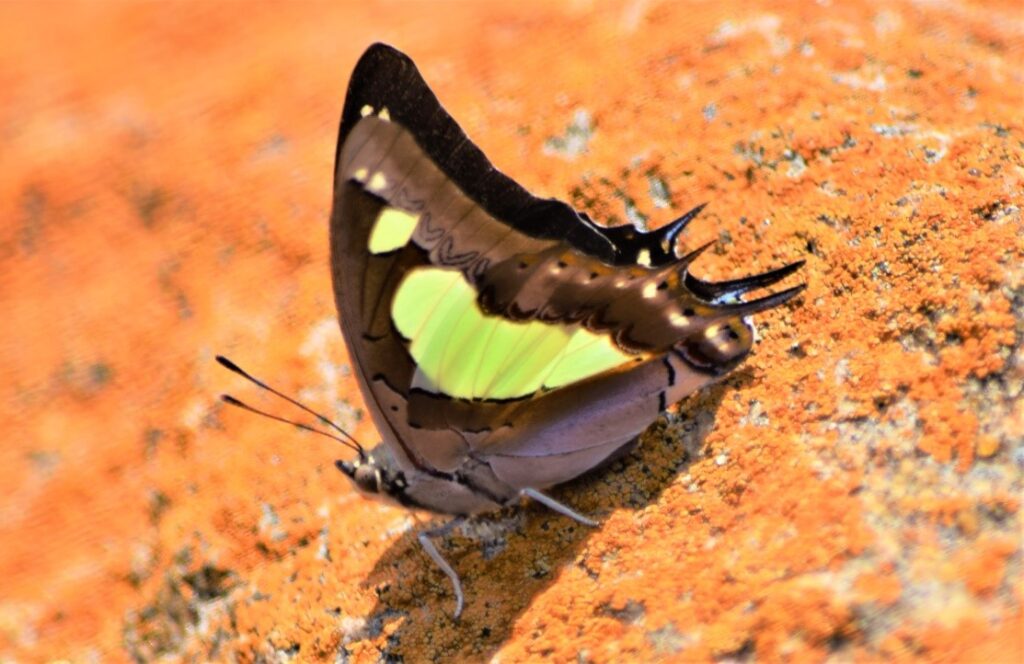Nature is often known to spring surprises to an audience capable of appreciating it. This was proved true for 14 members of Nature Watch (an Eco-Club from Bangalore) during their 1-day stint at Srirangam Tropical Butterfly Conservatory in Tiruchchirappalli (popularly also known as Trichy). With an area of 10 hectares, as the largest butterfly conservative zone in Asia, the conservatory is located between Kaveri and Kollodam River, in the vicinity of Upper Anicut Reserve Forest of Trichy.
The “Lepidoptera Workshop cum Walk”
The 1 day “Lepidoptera Workshop cum Walk” organized for Nature Watch members, in association with Tamil Nadu Forest Department; began with an educative session about Butterflies by Shri. D. Murugesan (Range Forest Officer, Trichy Forest Division), and culminated with a walk over paths that tread and traversed the entire park. While the workshop provided vital insight on the importance of preserving the butterflies and their habitats, the walk provided glimpses of the species observed.
At the end of the day, a total of 46 individuals belonging to 9 sub-families 28 genera were identified and recorded. However the highlight and startling moment from the walk was the unusual sighting of ‘Anomalous Nawab’ (Charaxes agraria) by Mr. Mohammed Ali Khan, (Coordinator – Lepidoptera Workshop and Student Member – Nature Watch).

About the Anomalous Nawab
Shri. Mohanprasath (Expert on Butterflies & Founder – Act for Butterflies & Advisor – OIKOS) explains that “Anomalous Nawab belong to the brush-footed butterfly’s family, and that the name is based on its resemblance to the Common Nawab (Charaxes athamas), a fast-flying canopy butterfly well described much before the discovery of this species. Belonging to Nymphalidae family and subfamily Charaxinae, Nawabs are well known for their robust bodies, fast flight and cryptic designs, and preferably like to feed on carrion, dung, rotten fruits and oozing sap. Anomalous Nawab is more of an enigmatic species in terms of its taxonomic status and geographic distribution. As a result of this confusion and the difficulty of field identification, there is not much information available on the distribution, habits and habitat preferences”.
The Unusually Low Altitude Sightings
Though Smiles (1982) enlisted Tiruchirappalli as one of the localities for the distribution within India, no published records for the nominate species in Trichy exist. In support, Shri. Niranjan Raj R (Expert on Butterflies – Bangalore Butterfly Club) who was part of this exercise and who pointed out this discovery; explains that “Anomalous Nawab is basically found and documented to be a medium to high altitude butterfly, and its presence at Trichy Butterfly Park is quite a surprise for the almost flat city situated at a lower altitude with an average elevation of 88 metres. While there have been records documented in Indian Foundation for Butterflies for sightings commonly in South India at locations in Bangalore, Hyderabad, Tiruvannamalai and in Central and North India, all have an average altitude greater than atleast 200-400m above msl”. Hence this is the first authenticated record for Anomalous Nawab at Trichy and for the park as well. Confirmed by Shri. D. Murugesan that “this butterfly now shall be an addition to our park’s checklist of already confirmed 90 species”.
A lifer as Wildlife enthusiasts would call it, but Dr Rajesh Gopinath (Expert on Urban Climatology & Key Liaison – Nature Watch & OIKOS), who was also part of this exercise, has a different take on this sighting as an Advocatus Diaboli.
Climate Change can alter Micro-Habitats
In his own words, “I have in past experiences seen Anomalous Nawab at Horaginbetta (Nandi Hills, Chikkaballapur Dist., 1,478m above msl) and at Melukote (Paandavapura, Mandya Dist., 900 m above msl); so this sighting comes as a pleasant surprise stressing to explore the need for a medium altitude butterfly to migrate to lower altitudes. Considering that they are cold-blooded, i.e., they cannot regulate their own body temperature and as a result that their body temperature changes with the temperature of their surroundings; it’s most probable that climate shift is forcing them to shift terrains and migrate downhill. Climate change holds potential to introduce total transformation of the micro-climate for any location, which can result not only in loss of their breeding grounds but also permanent shifting of the base. This consequently impacts floral population since butterflies are also pollinators; thereby resulting in eventual denudation of soil or loss of a specific plant species or even a significant decline in viable seed production; which again can result as loss of a potential host plant or larvae plant for the same or some other butterfly species. Further, this also means that there shall be stress on survival aspects in terms of habitat and competition for food with inadvertent implications as well”. While concluding he includes the famous words of Shri Rabindranath Tagore that “The butterfly counts not months but moments, and has time enough… However with Climate Change, there is a different say all together if our needless actions are not curtailed”.
This species is not the only one impacted by climate change. The Himalayan Brown and Asiatic Black Bears also have shortened hibernation in response to altered food availability due to warmer temperatures. In fact, climate change is easily one of the worst threats faced by wildlife.
About the Author
Dr. Rajesh Gopinath (Associate Professor & HoD, Department of Civil Engineering & Key Liaison – OIKOS (Eco Club), BMS Institute of Technology and Management, Bengaluru 560064) is an avid Nature Enthusiast by Passion and essentially an Environmental Engineer by Qualification. His various Environmental articles have been published in Jamaican Media (on eve of World Environment Day), Newsletters of Bharat Electronics Limited (B.E.L.), and other popular News Dailies etc. This apart, his various Environmental Articles have also been published as Book Chapters. He is an advisor to various Eco-Clubs and Environmental NGOs based in India.
